
Using GRID for Regional Population,
Agriculture
and Natural Hazards Modeling
Population increase and migration into areas under threat of natural hazards is a global concern. Earthquakes, tsunamis, volcanoes, cyclonic storms and floods endanger increasing populations and their sustaining agriculture.
Earth
Satellite Corporation worked with iSciences, L.L.C. to develop a GIS that
synthesizes the relationship of regional population increase, the value of
sustaining agriculture and natural hazards (earthquakes, tsunamis, volcanoes and
cyclonic storms) that threaten them. The GIS includes ArcInfo scripted models,
map databases, statistics, cartographic products and ArcView projects for the
Tigris-Euphrates (including Iraq, Syria and Turkey), Indonesia, Nigeria, and
South Asia (including India, Pakistan, and Bangladesh) regions.
Using GRID for Regional Population,
Agriculture
and Natural Hazards Modeling

Earth
Satellite Corporation teamed with iSciences to address three critical
geographical questions. Firstly, what is the location and extent of population
and agriculturally prime areas at a regional scale? Secondly, what is the
location and extent of natural hazards such as earthquakes, floods, cyclonic
storms, desertification, tsunamis and volcanoes? Lastly, what is the
relationship between population, agriculture, and infrastructure with natural
hazards? Using raster-based GIS modeling these questions could be addressed.
Study
Area
The
project selected a number of geographically diverse study areas for
regional-scale analysis. South Asia, including Bangladesh, India, and Pakistan,
the Tigris Euphrates region, including Turkey, Iraq and Syria, in addition to
Nigeria, and Indonesia were chosen for analysis. The analysis was conducted at 1
km2 cell resolution.
Data
Sources
Publicly
available data and information served as the source of inputs to the GIS
analysis.
Vector-based
spatial data was likewise obtained from publicly available sources. Spatial data
contained in the Defense Mapping Agency’s 1:1,000,000 Digital Chart of the
World (DCW) served as a complete source of regional-scale base information.
Raster
structure spatial data were also acquired from publicly available sources. NOAA
provided a number of data sets including precipitation and desertification
hazard. The International Geosphere Biosphere (IGBP) program provided global 1
km2 land cover. The NOAA DMSP program provided global coverage of
nighttime persistent bright lights. The USGS EROS data center’s GTOPO30
database served as an elevation model.
Hardware and Software
Earth
Satellite Corporation’s Sun Enterprise 4000 and StorageTek 9710 Library
Storage Module was the primary hardware resource for the project. Analysts also
used Intel Xeon personal computers for client connectivity and analysis work.
Operating system software included SUN Solaris and Windows NT 4 (SP 6). GIS
software included Environmental Systems Research Institute’s ArcInfo 8. All
analytical processing was conducted using ArcInof GRID. Cartography was
conducted using ArcView 3.2. Some
image processing was conducted using ERDAS Imagine 8.3.
Findings and Methods
The
project developed a series of models to address the critical geographic
questions identified. These included population density, agricultural primeness
and natural hazards models. The resulting output surfaces were combined to
identify population, agriculture and infrastructure exposed to significant
natural hazards.
Population Models
The
project produced km2 resolution population density for the late 1990s
and forecasted 2010 population. The model is a disaggregation
of first order administrative (state/provincial) population to the km2
level.
Rural Population
State-level rural population totals for all countries were obtained through the US Department of Commerce US Census Bureau International Program. These state-level rural figures were allocated to 1 km2 pixels based on a multicriteria suitability model.
A
surface of total suitability based on multiple criteria was developed for rural
areas. Higher suitability areas would receive higher proportions of the total
state level population. Criteria for rural population allocation included
|
–Proximity to settlements. Settlements are considered the best indicator of a
population center. |
|
–Proximity to transportation
infrastructure. Roads and rail also act as a magnet to settlement. |
|
–IGBP land cover. Agricultural and built up land cover types were given a higher suitability for
settlement, compared with barren land or other land cover types. |
|
–Proximity to rivers/streams. Rivers and streams were also modeled as magnets
for settlement. |
|
–Topographic and Land cover screen. Areas of steep slope were considered
unsuitable for settlement. Water and wetlands were also used as a screen to avoid
allocation of population in open water or wetland. |
Urban
Population
Urban
population density modeling took a similar approach. State level urban
population estimates from local national censuses were allocated to the cellular
(1 km2) level. A different criteria set was applied in the
allocation:
|
–DMSP persistent nighttime lights. Density of the electricity infrastructure as indicated by the DMSP persistent nighttime lights surface is an appropriate indicator for density of population. |
|
–Transportation infrastructure density. Urban areas with high regional transportation density received a higher suitability score for population. |
|
–Regional urban density.
Areas of high regional urban agglomeration also received higher suitability. |
|
–Topographic and Land cover screen. Again areas of steep slope or wetland/open water areas were considered unsuitable for settlement. |
US
Census Bureau estimates of national level population for each country for 2010
were available online. The subnational urban and rural
population estimates available from local national censuses were proportionally
weighted to produce 2010 state level population estimates. These estimates were
then used as inputs through the same allocation process described above for km2-level
population modeling.
The
resulting urban and rural population density GRID surfaces were combined to
produce a complete population density per km2 surface for 1998-9 and
2010 for all study areas.

|
|
Population
Density 1998, India-Bangladesh Boundary Region. |
Agricultural Primeness
The
project developed a surface of agricultural primeness, or suitability of the
landscape for agricultural use. The
model used two compound weighted criteria (physical and socio-economic factors)
to index suitability in a raster surface:
1.
Physical Characteristics
These
layers are modeled to reflect the physical characteristics of the landscape that
favor agriculture. The three selected component criteria were soils, moisture availability
and land cover:
| - Availability of Moisture. |
|
Average annual rainfall. Areas of high renewable water resource are given higher
suitability for agriculture. |
|
Access to streams (based on a cost surface). Areas with access to surficial water are given higher suitability ratings. |
|
- Soil Suitability |
|
Soil type/agricultural productive potential. Individual soil types were evaluated for their suitability for agriculture and mapped. |
|
Slope. Lower, gentle slopes were given higher suitability for agricultural use. |
|
- Land Cover |
|
Land cover suitability for agricultural use. Existing agricultural lands were given the highest suitability ratings, while barren land cover and open water
received lower ratings. |
2.
Socio-economic Characteristics
A
single socio-economic layer that reflects access to demand centers for
agricultural products was produced. This surface assigns high agricultural
primeness scores to areas that have easy access to higher density population
centers, and lower agricultural primeness scores to areas that have poor access
to low-density population centers:
|
- Access to demand for agricultural products. |
|
Access to settlements, which acts as agricultural demand centers, is based on a cost surface. Movement from through a friction surface, based on slope, to settlement areas was modeled. The relative attractiveness of low, moderate, and high population centers affects the suitability of the landscape for agricultural use. |
The
result is a composite agricultural primeness GRID surface that shows relative
suitability of the landscape for agriculture.
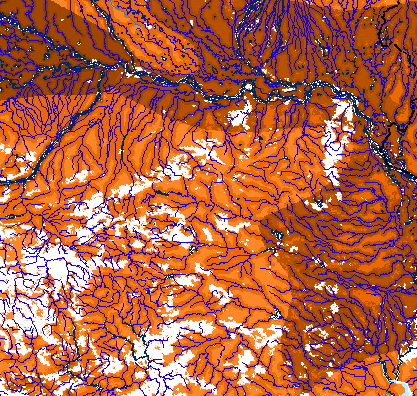
|
|
Primeness
of Agricultural Lands, India-Bangladesh Region. |
Natural Hazards
A
series of natural hazards surfaces were modeled and compiled from existing
sources.
Earthquake
The earthquake hazard surface portrays the likely damage in Mercalli scale over the next fifty years from Earthquakes. Earthquake data was obtained from ‘The World Map of Natural Hazards’, Munchener Ruckversicherungs-Gesellschaft, as provided by the UNEP GRID Natural Hazards Database on Earthquakes and ingested to the GIS.
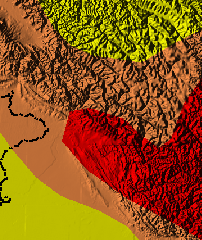
|
|
Earthquake
Hazard, India-Pakistan Boundary Region. |
Topographic Flood Hazard
The flood hazard model assesses the topographic risk of flooding throughout the project study areas. The flood hazard map is not event specific. Instead, the model assesses all areas for the relative cost of water migration from a source inundated area or river to derive flooding potential. Flat areas close to rivers, and areas near wetlands are characterized as more subject to flooding. A topographic cost surface that models the cost of migration of water from source wetlands and rivers is produced and interpreted to identify risk of flooding. Areas of lower cost of water migration are assigned higher risk values, while areas of higher cost of water migration are given lower risk values.
Source rivers, streams and wetlands were obtained from the 1:1,000,000 Digital Chart of the World (DCW). Source elevation data was obtained from the EROS data center 1996 30 Arc Second USGS gtopo30 map database.
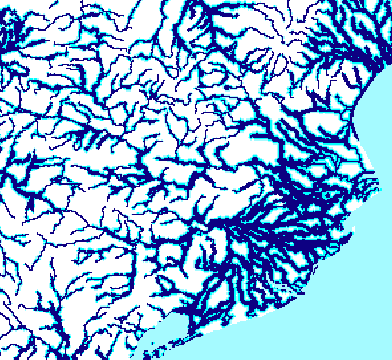
|
Topographic Flood Hazard, Orissa Region, India. Light blues indicate lower flood potential, while darkest blues show areas of greatest hazard. |
Cyclonic Storms Hazard
The
storm risk model maps the regional historical density of cyclonic storm intensity from
November 1971 to November 1995.
All
historical cyclonic storm and tropical depression center tracks recorded from
1971 – 1999, provided by NOAA historic data compiled by Global Tracks, served
as model input.
The
regional line density (within a 500 km distance) of cyclonic storm and tropical
depression center tracks was calculated for each 1 km2 cell in the
study area. Storm intensity was used as a weighting factor in
modeling regional density. Tropical depressions represented the lowest line
density weight, and higher category typhoons/hurricanes were given higher line density
weightings. The resulting weighted density surface was then categorized into
low, low-moderate, high-moderate, and high-risk categories to represent risk
variance.
The
result is a risk surface GRID showing the historical (1971 - 1995) risk of
cyclonic storms and tropical depressions throughout the study areas. The risk
surface represents the regional frequency, density, and intensity of cyclonic
storm activity.
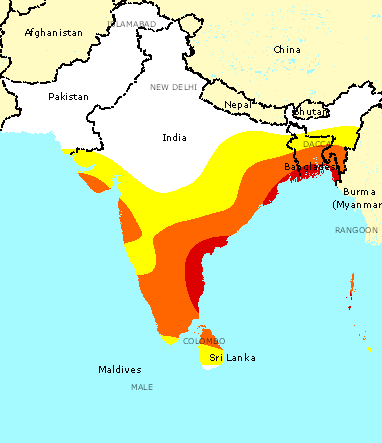
|
South
Asia Cyclonic Storm Hazard. |
Desertification Hazard
The desertification layer actually expresses the deserts of the study area as well as a rim of potential desertification. The layer used in this study is derived from a dataset created by David Hastings of NOAA (Hastings and Di 1993).
The original layer was based on NOAA AVHRR
imagery. The imagery was processed earlier as part of NOAA's Global Change
Database (GCDB), which consists of NDVI processed AVHRR imagery. It is a
collection of monthly global NDVI compilations produced from April 1985 to
December 1988 and derived from NOAA’s Global Vegetation Index (GVI) (Hastings
and Di 1992). The GVI was created by producing weekly NDVIs of AVHRR data and
then removing the highest and lowest values of each image, then taking the root
mean square of the remaining values. Then this information was composited into
monthly data. This was done to reduce spurious NDVI high values and some cloud
contamination (Hastings and Di 1992). This data was analyzed to determine areas
of no vegetation growth. The number of years the data covers and the many months
of data utilized negated the effects of short-term drought causing an
over-estimation of desert area, or the under-estimation of desert due to rare
precipitation (Hastings and Di 1992).
Next
a “fragile fringe” or marginal zone between desert and vegetated areas was
determined using NDVI analysis as well. Also, local expertise was used in North
Africa and the Arabian Peninsula to detect the threshold between these land
cover types. Values below 56 on an 8-bit image were labeled as desert. The
fringe areas were placed at 57-76. These fringe areas include irrigated desert
areas used for agriculture. The marginal areas are interpreted as sparse
vegetation on the edges or within deserts that are at risk for desertification.
Some areas expressed as marginal are surrounded by healthier vegetation.
Hastings interprets these areas as damaged by overgrazing or other wasteful
activities (Hastings and Di 1992). Values over 76 are expressed as vegetated
areas. This methodology has produced the most accurate global map of deserts and
marginal areas (Hastings and Di 1992).
This
data set is unavailable to the public due to its having been misplaced by its
principal investigator. Therefore unconventional means were utilized to process
this information. The web page containing the above describe data in a graphic
was displayed and the gif image was saved to a local hard-drive. There it was
converted to a bitmap image using Microsoft
Paint, then it was converted from bitmap to tiff format using Imaging for Windows NT. The tiff file was finally imported into Imagine
as a 256 class thematic layer rather than a continuous image. This was to avoid
having to classify the image later, as the features were already very well
separated by color. Before rectification the file was windowed to the area of
study so as to minimize number of pixels to be processed and improve
spatial accuracy.
In
Imagine the file was rectified to the IGBP data set previously collected for
this study. The original projection information was not known. The IGBP layer is
also based on AVHRR imagery so it was hoped there would be some inherent
similarities in the data spatially. Therefore a polynomial order of 2 was used.
Eleven GCPs were used which were located around apparent water bodies. The image
was resampled during the process to 1 km and a bilinear convolution resampling
method was used, while the grid sampling x and y values were set at 200. After
rectification, it was necessary to recode the areas around water bodies within
screen-digitized AOIs because the shore values were affected by being averaged
during the bilinear resampling. Then these recoded areas were mosaicked over the
layer to correct this problem. The threshold for setting pixels on the shore
area to water or vegetated was 56, the same as was used in the original layer to
distinguish between desert and prone areas. The resulting mosaic was then subset
so that its shape would be rectangular instead of the warped look inherent from
the rectification. Unfortunately there is some missing data in the study area
that was simply not available on the web image. All the missing area is fully
vegetated however.
Since the data was imported as a thematic layer, it was readily processed into a thematic map by recoding the 256 classes into 2 and 4 classes. The 2 class map includes a desert class and an at risk class. The 4-class map includes: water, vegetated, desert, at risk. The results were exported to GRID for use in ArcInfo.
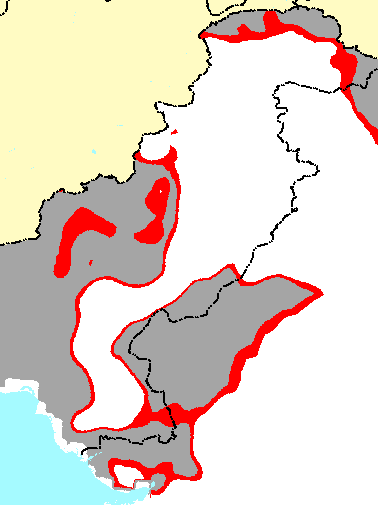
|
|
Desertification Hazard, India-Pakistan Boundary Region. Existing deserts are shown in gray, while areas prone to desertification are shown in red. |
Tsunami Hazard
A
surface showing the potential hazard of tsunami landfall was developed from the
NOAA National Geophysical Data Center Tsunami Event Database. This event
database included the longitude and latitude for the epicenter of earthquakes
that caused "definite tsunamis" from 1600 - 1999.
Risk
was determined by modeling the cost of water movement through a friction surface
based on land elevation and distance from all source tsunami earthquakes. The result was
an accumulation of risk based on cost distance. Lower cost areas are typically
in low-lying shore areas, closer to multiple known tsunami earthquake
epicenters.
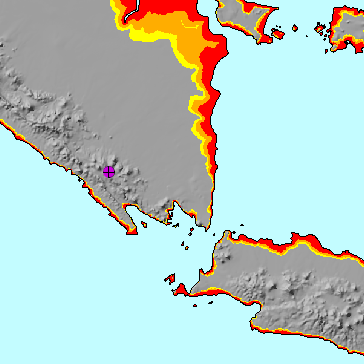
|
|
Tsunami
Hazard, Jawa Barat-Sumatra, Indonesia Region. |
Volcano Hazard
The
Volcanic Hazard surfaces show the potential threat of volcanic activity based on
Smithsonian (provided by the National Geophysical Data Center) average recorded
Volcanic Eruptivity Index (VEI) for each volcano recorded. Blast hazard, and
volcanic ash fallout hazard are the two component criteria applied in the model.
Blast Hazard
Blast
hazard is modeled as an area at immediate risk of exposure to ejected debris and
the explosive force of a volcanic eruption. The extent of this risk zone is tied
to the average Volcanic Eruptivity Index (VEI) for a given volcano. Higher VEI
average volcanoes have larger, more forceful explosions which pose hazard to
larger geographic extents. Conversely, volcanoes with lower VEI averages have
weaker explosions whose blast zones do not extend to great distances. Areas that
are directly visible from a volcano caldera are potentially vulnerable to blast.
Areas hidden by topography are not visible to the caldera, and are at lower risk
of blast damage. The greater the VEI, the greater the distance to which blast
vulnerability is modeled. Areas within this modeled blast zone receive a high
risk score.
Volcanic Ash Fallout
Volcanic
ash fallout hazard identifies areas that are potentially at risk of exposure to
falling volcanic ash in the event of volcanic eruption. The extent of volcanic
ash fallout is directly related to the average Volcanic Eruptivity Index (VEI)
value for the candidate volcano. Higher VEI averages have higher plume heights
and ejecta volume, and consequently fallout zones of greater geographic extent.
Lower average VEI volcanoes have lower plume heights and ejecta volume.
Consequently, the corresponding fallout risk zones have a more limited
geographic extent. Fallout areas closer to the volcano caldera receive a higher
risk score. This score decays as distance from the caldera increases.
Blast hazard and volcanic ash fallout hazard scores are combined in additive overlay to produce a risk surface for an individual volcano. The risk surfaces for each volcano in the study area are then combined into a single layer of aggregate risk. Areas that are proximate to multiple high VEI average volcanoes are at greater risk than areas that are remote to low VEI average volcanoes.
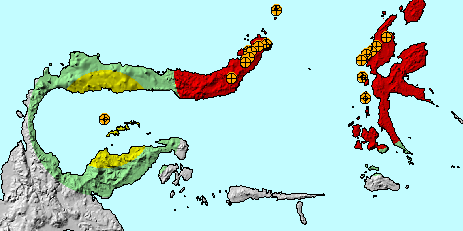
|
|
Volcano Hazard, Sulawesi Utara – Maluku, Indonesia Region. Lower hazard areas are shown in green tones, while greatest hazard areas are shown in reds. Known historically active volcanoes are shown as orange circles with crosshairs. |
The series of natural hazards GRIDS directly addressed our first critical question by identifying the location and extent of the population, agriculture and the most significant natural hazards throughout our study areas.
Population, Agriculture, Infrastructure and Natural Hazards
The
second critical question our project proposed to answer, the relationship
between population, agriculture, and natural hazards, is also addressed through
GIS modeling.
Simple
GIS overlay of high population density areas, transportation network
information, and agricultural areas with any combination of natural hazard GRIDs
will produce complex composite surfaces which show populations, agriculture and
transportation infrastructure at risk.
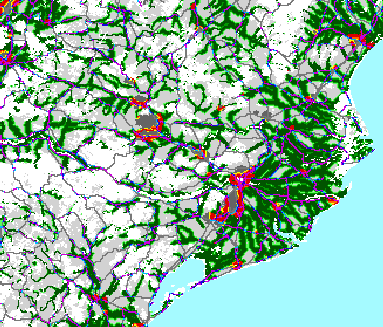
|
|
Population,
Infrastructure and Agriculture under Flood Hazard |
The
total population and acreage of agricultural lands at risk may be quantified by
any geographic enumeration. For instance, the following table summarizes Indian
populations 1960, 1998, and 2010 by earthquake risk zone :
|
India |
|
%
of Population |
%
Change 1960-1998 |
%
Change 1998-2010 |
%
Change 1960-2010 |
|
|
|
|
|
|
|
|
Population Dynamics |
|
|
|
|
|
|
Population 1960 |
424,391,200 |
|
|
|
|
|
Population 1998 |
960,421,700 |
|
|
|
|
|
Population Projection
2010 |
1,182,171,000 |
|
126.3% |
23.1% |
178.6% |
|
|
|
|
|
|
|
|
Earthquake Risk
Assessment |
|
|
|
|
|
|
Earthquake v.
Population 1960 |
424,391,200 |
100% |
|
|
|
|
Very Low |
72,846,570 |
17.2% |
|
|
|
|
Moderate |
313,060,400 |
73.8% |
|
|
|
|
Moderate High |
30,109,220 |
7.1% |
|
|
|
|
High |
8,375,010 |
2.0% |
|
|
|
|
|
|
|
|
|
|
|
Earthquake Risk
Assessment |
|
|
|
|
|
|
Earthquake v.
Population 1998 |
960,421,700 |
100% |
|
|
|
|
Very Low |
167,902,960 |
17.5% |
0.3% |
|
|
|
Moderate |
703,184,100 |
73.2% |
-0.6% |
|
|
|
Moderate High |
68,633,390 |
7.1% |
0.1% |
|
|
|
High |
20,701,250 |
2.2% |
0.2% |
|
|
|
|
|
|
|
|
|
|
Earthquake v.
Population 2010 |
1,182,171,000 |
100% |
|
|
|
|
Very Low |
205,529,530 |
17.4% |
|
-0.1% |
0.2% |
|
Moderate |
868,195,300 |
73.4% |
|
0.2% |
-0.3% |
|
Moderate High |
83,314,900 |
7.0% |
|
-0.1% |
0.0% |
|
High |
25,131,270 |
2.1% |
|
0.0% |
0.2% |
Currently
the models produced do not reflect calibration based on detailed empirical data
obtained from fieldwork. Many of the geographic themes produced have never been
field surveyed in detail. It is anticipated that as field survey information is
developed, the models will be refined and calibrated to fit the evidence
contained in sources of higher accuracy.
Hastings,
David A. and Di, Liping. Characterizing the Global Environment: An Example Using
AVHRR to Assess Deserts, and Areas at Risk of Desertification. NOAA NGDC,
published on website: www.ngdc.noaa.gov/seg/globsys/gisdes.shtml.
1993. 10pp.
The author wishes to acknowledge the contributions of David Cunningham of Earth Satellite Corporation and Douglas Way of iSciences for their direction and leadership in this GIS project. Thanks also to François Smith and Yasmine Naficy of Earth Satellite Corporation for their efforts in the project.
Jeffrey B. Miller
Staff Scientist
Earth Satellite Corporation
6011 Executive Boulevard Suite 400,
Rockville, MD 20852-3804
(301) 231-0660
FAX (301) 231-5020
jmiller@earthsat.com
http://www.earthsat.com